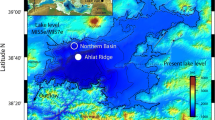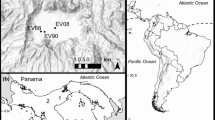Abstract
Medicine Lake is a highly saline meromictic lake in eastern South Dakota. A lithostratigraphic and biostratigraphic study of the late-glacial and early post-glacial sediments shows that it was a relatively deep dilute freshwater lake during the period of the Picea pollen zone. When spruce forest changed to a Betula and then to a Quercus/Ulmus woodland in the early post-glacial period, the lake water became more concentrated but remained fresh. However, during the subsequent rapid transition to prairie in the early Holocene, when Gramineae, Ambrosia, and Artemisia dominated dry-land vegetation, the freshwater diatom flora was progressively replaced by a saline assemblage characterized by Cyclotella quillensis, Chaetoceros, and eventually Cyclotella caspia. The lake became permanently saline at about 9000 yr BP. A comparison of the fossil diatom assemblages with surface-sediment samples from a range of lakes in the Dakotas indicates that the change involved an increase in conductivity from about 500 μS cm−1 in the late-glacial period to > 10 000 μS cm−1 in the early Holocene. This rapid change is also marked by an abrupt increase in sulphate concentration in the sediment, the first appearance of bands of gypsum crystals, and the beginning of a well-laminated core sequence that continues through the remaining sediment record. Conditions of high salinity have prevailed to the present day.
Similar content being viewed by others
References
Barari, A., 1971. Hydrology of Lake Kampeska. South Dakota Geological Survey Report. Investigation 103, 1–84.
Battarbee, R. W., 1973. A new method for estimating absolute diatom numbers with special reference to diatoms. Limnol. Oceanogr. 18: 647–653.
Battarbee, R. W., C. M. Keister & J. P. Bradbury, 1983. The frustular morphology and taxonomic relationship of Cyclotella quillensis Bailey. Proceedings of Seventh International Diatom Symposium: 173–184.
Bradbury, J. P., B. Leyden, M. Salgado-Labouriau, W. M. Lewis, C. Schubert, M. W. Binford, D. G. Frey, D. R. Whitehead & F. H. Weibezahn, 1981. Late Quaternary environmental history of Lake Valencia, Venezuela. Science 214: 1299–1305.
Brugam, R. B., 1980. Postglacial diatom stratigraphy of Kirchner Marsh, Minnesota. Quat. Res. 13: 133–146.
Brugam, R. B., 1983. The relationship between fossil diatom assemblages and limnological conditions. Hydrobiologia 98: 223–235.
Dean, W. E., 1974. Determination of carbonate and organic matter in calcareous sediments and sedimentary rocks by loss on ignition: comparison with other methods. Sediment Petrology 44: 242–248.
Digerfeldt, G., 1986. Studies on past lake-level fluctuations. In ‘Handbook of Holocene Palaeoecology and Palaeohydrology’ (B. E. Berglund, Ed.) pp. 127–143. J. Wiley & Sons, Chichester.
Engstrom, D. R. & H. E. Wright, 1984. Chemical stratigraphy of lake sediments as a record of environmental change. In ‘Lake Sediments and environmental history’ (E. Y. Haworth & J. W. G. Lund, Eds.) pp. 11–68. Leicester University Press.
Eugster, H. P. & L. A. Hardie, 1978. Saline lakes. In ‘Lakes, Chemistry, Geology, Physics’ (A. Lerman, Ed.) pp. 237–294. Springer-Verlag, New York.
Faegri, K. & J. Iversen, 1975. ‘Textbook of pollen analysis’ Hofner Press, New York, 295 pp.
Flint, R. F., 1955. Pleistocene geology of eastern South Dakota. Geological survey Professional Paper 262.
Florin, M-B. & H. E. Wright, 1969. Diatom evidence for the persistence of stagnant glacial ice in Minnesota. Geological Society of America, Bulletin 80: 695–704.
Fritz, S. C. & R. W. Battarbee, 1988. Sedimentary diatom assemblages in freshwater and saline lakes of the Northern Great Plains, North America: preliminary results. Proceedings of the Ninth Symposium on Living and Fossil Diatoms, Bristol, England (in press).
Gordon, A. & H. J. B. Birks, 1972. Numerical methods in quaternary palaeoecology 1. Zonation of pollen diagrams. New Phytol. 71: 961–979.
Haworth, E. Y., 1972. Diatom succession in a core from Pickerel Lake, northeastern South Dakota. Geological Society of America, Bulletin 83: 157–172.
Jackson, M. L., 1958. ‘Soil Chemical Analysis’ 498 pp. Prentice-Hall Inc. New Jersey.
Kapp, R. O., 1969. ‘How to know pollen and spores’ 249 pp. W. C. Brown, Iowa.
Last, W. M. & T. H. Schweyen, 1983. Sedimentology and geochemistry of saline lakes of the Great Plains Hydrobiologia 105: 245–263.
Last, W. M. & T. H. Schweyen, 1985. Late Holocene history of Waldsea Lake, Saskatchewan, Canada. Quat. Res. 24: 219–234.
McAndrews, J. H., 1966. Postglacial history of prairie, savanna and forest in northwestern Minnesota. Torrey Botanical Club Memoir 22: 1–72.
McAndrews, J. H., R. E. Stewart, R. C. Bright, 1967. Palaeoecology of a prairie pothole: a preliminary report. In ‘Glacial geology of the Missouri Coteau and adjacent areas’ (L. Clayton & T. F. Freers, Eds.) pp. 1–70. North Dakota Geological Survey, Miscellaneous Series 30.
McAndrews, J. H., A. A. Berti & G. Norris, 1973. ‘Key to the Quaternary pollen and spores of the Great Lakes region’ 61 pp. University of Toronto Press.
Radle, N., 1981. Vegetation history and lake-level changes at a saline lake in northeastern South Dakota. Unpublished MS thesis, University of Minnesota.
Richardson, J. L., 1969. Former lake-level fluctuations-their recognition and interpretation. Mitt. int. Ver. Limnol. 17: 78–93.
Richtie, J. C. & S. Lichti-Federovich, 1968. Holocene pollen assemblages from the Tiger Hills, Manitoba. Can. J. Earth Sci. 5: 873–880.
Thomas, J. F. & J. E. Cotton, 1954. A turbidimetric sulfate determination. Water and Sewage Works: 462–465.
Tipton, M. J., 1958. Geology of the Still Lake, Henry and Florence quadrangles South Dakota Geological Survey, Geology Quadrangle.
Tipton, M. J., 1975. Quaternary glacial deposits and alluvium. in ‘Mineral and water resources of South Dakota’. United States Geological Survey.
van Zant, K., 1979. Late-glacial and postglacial pollen and plant macrofossils from Lake West Okoboji, northwestern Iowa. Quat. Res. 12: 358–380.
Waddington, J. C. B., 1969. A stratigraphic record of the pollen influx to a lake in the Big Woods of Minnesota. Geological Society of America, Special Paper 123: 263–282.
Watts, W. A. & R. C. Bright, 1968. Pollen, seed, and mollusk analysis of a sediment core from Pickerel Lake, north-eastern South Dakota. Geological Society of America, Bulletin 79: 855–876.
Watts, W. A. & T. C. Winter, 1966. Plant macrofossils from Kirchner Marsh, Minnesota: a palaeoecological study. Geological Society of America, Bulletin 77: 1339–1360.
Williams, W. D., 1981. Inland salt lakes: an introduction. Hydrobiologia 81: 1–14.
Wright, H. E., 1967. A square-rod piston sampler for lake sediments. Journal of Sedimentary Petrology 37: 975–976.
Wright, H. E., 1976. The dynamic nature of Holocene vegetation-a problem in palaeoclimatogy, biogeography and stratigraphic nomenclature. Quat. Res. 6: 581–596.
Wright, H. E., T. C. Winter, H. L. Patten, 1963. Two pollen diagrams from southeastern Minnesota: problems in the regional late-glacial and postglacial vegetational history. Geological Society of America, Bulletin 74: 1371–13.
Author information
Authors and Affiliations
Additional information
Contribution 299, Limnological Research Center.
Rights and permissions
About this article
Cite this article
Radle, N., Keister, C.M. & Battarbee, R.W. Diatom, pollen, and geochemical evidence for the palaeosalinity of Medicine Lake, S. Dakota, during the late-Wisconsin and early Holocene. J Paleolimnol 2, 159–172 (1989). https://doi.org/10.1007/BF00202044
Received:
Issue Date:
DOI: https://doi.org/10.1007/BF00202044




